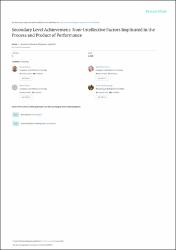| dc.contributor.author | McIlroy, David | |
| dc.contributor.author | Palmer-Conn, Sue | |
| dc.contributor.author | Lawler, Bridget | |
| dc.contributor.author | Poole, Karen | |
| dc.contributor.author | Ursavas, Ömer Faruk | |
| dc.date.accessioned | 2020-12-19T19:48:44Z | |
| dc.date.available | 2020-12-19T19:48:44Z | |
| dc.date.issued | 2017 | |
| dc.identifier.citation | McIlroy, D., Palmer-Conn, S., Lawler, B., Poole, K. & Ursavas, O.F. (2017) Secondary Level Achievement Non-Intellective Factors Implicated in the Process and Product of Performance. Journal of Individual Differences, 38 (2). http://dx.doi.org/10.1027/1614-0001/a000227 | en_US |
| dc.identifier.issn | 1614-0001 | |
| dc.identifier.issn | 2151-2299 | |
| dc.identifier.uri | https://doi.org/10.1027/1614-0001/a000227 | |
| dc.identifier.uri | https://hdl.handle.net/11436/2151 | |
| dc.description | URSAVAS, Omer Faruk/0000-0002-5759-7894; Mcilroy, David/0000-0001-6502-2938 | en_US |
| dc.description | WOS: 000404998200005 | en_US |
| dc.description.abstract | The study was developed in the context of Personality and Social Cognitive Theory with constructs that encapsulate non-intellective processes of academic achievement. the goal was to explore the role of the Five Factor Model (FFM) of personality in academic performance and to use this model as a reference point to test the incremental validity of two measures of Self-efficacy (Academic and Emotional) and an indicator of Absenteeism. Participants (N = 120) were comprised of 17-year-old male (n = 47) and female (n = 73) opportunistically sampled secondary level college students. A cross-sectional design was used to examine the relationship between the independent variables (FFM, Academic Self-efficacy, Emotional Self-efficacy, and Absenteeism) and the outcome variable, Grade Points Average (GPA). Correlation analysis found that four FFM factors and the two Self-efficacy measures were associated with GPA. in a hierarchical regression analysis, the FFM explained 22% variance on performance and the two Self-efficacy measures added 9% incremental variance followed by 3% for Absenteeism. Overall, the non-intellective constructs explain a substantial 34% variance on achievement and provide focal points for theoretical, empirical, and pedagogical evaluation. Moreover, they are suggestive of the pathways and processes that support learning, augment ability, and enhance achievement. | en_US |
| dc.language.iso | eng | en_US |
| dc.publisher | Hogrefe & Huber Publishers | en_US |
| dc.rights | info:eu-repo/semantics/openAccess | en_US |
| dc.subject | Personality | en_US |
| dc.subject | Self-efficacy | en_US |
| dc.subject | Attendance | en_US |
| dc.subject | Secondary education | en_US |
| dc.subject | Academic achievement | en_US |
| dc.title | Secondary level achievement non-intellective factors implicated in the process and product of performance | en_US |
| dc.type | article | en_US |
| dc.contributor.department | RTEÜ, Eğitim Fakültesi, Bilgisayar ve Öğretim Teknolojileri Eğitimi Bölümü | en_US |
| dc.contributor.institutionauthor | Ursavas, Ömer Faruk | |
| dc.identifier.doi | 10.1027/1614-0001/a000227 | |
| dc.identifier.volume | 38 | en_US |
| dc.identifier.issue | 2 | en_US |
| dc.identifier.startpage | 102 | en_US |
| dc.identifier.endpage | 112 | en_US |
| dc.ri.edit | oa | en_US |
| dc.relation.journal | Journal of Individual Differences | en_US |
| dc.relation.publicationcategory | Makale - Uluslararası Hakemli Dergi - Kurum Öğretim Elemanı | en_US |


















